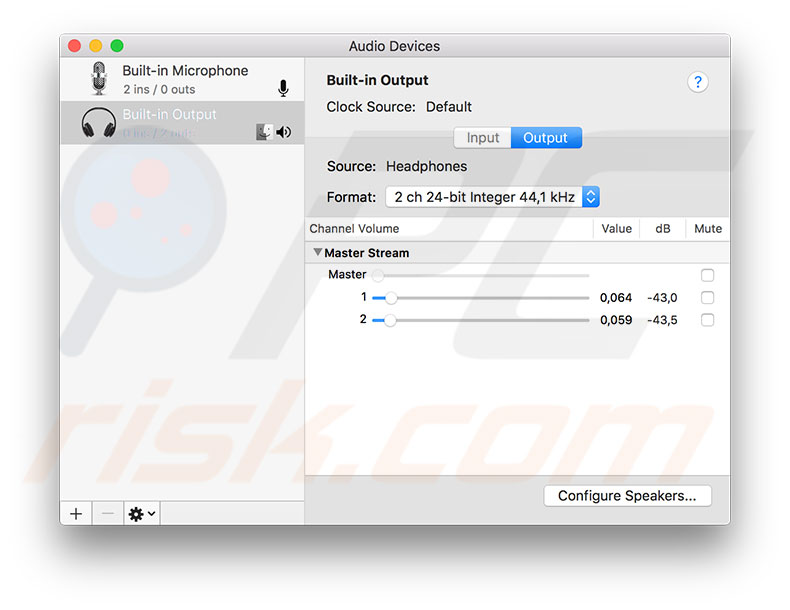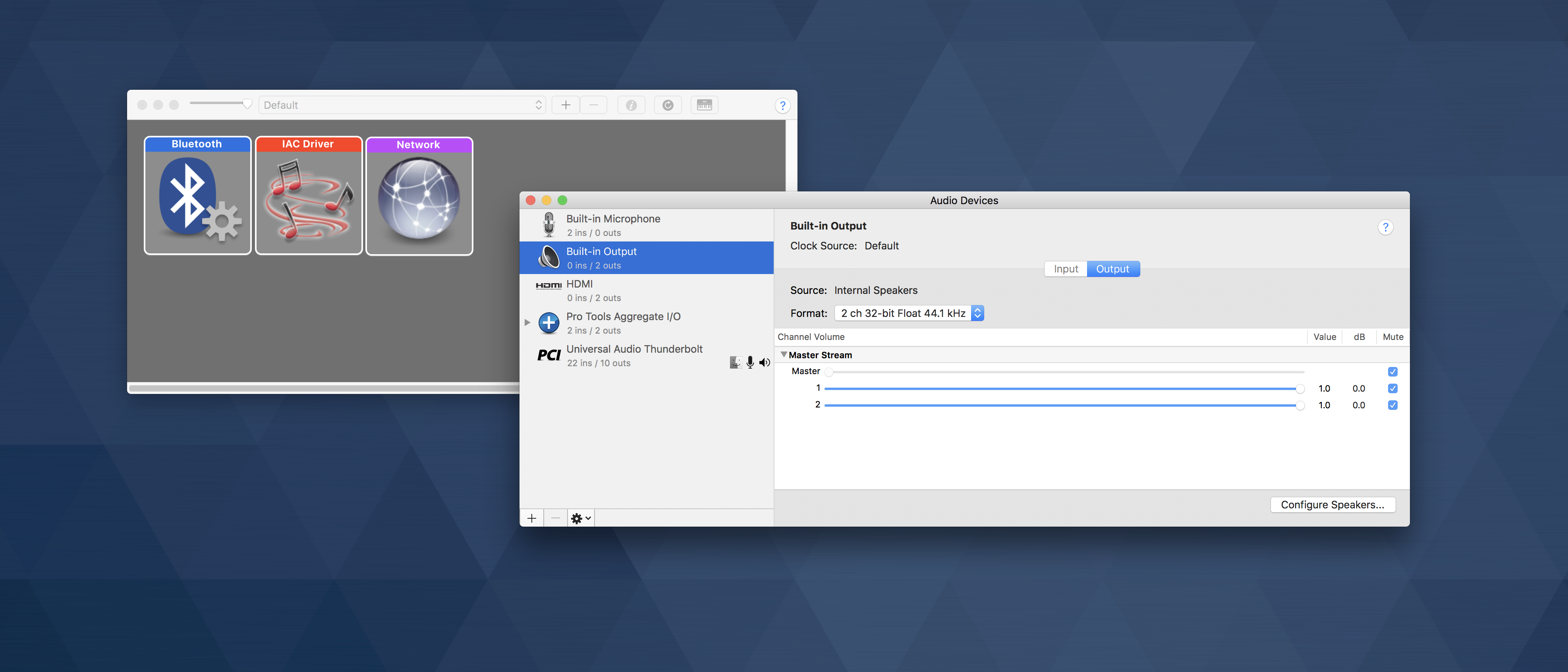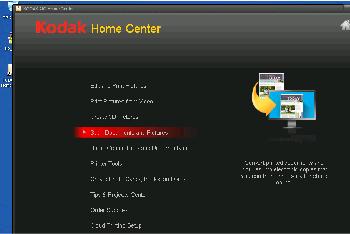This is a collection of device images for the Audio/MIDI set-up application featured in Mac OS X. It will allow you to make MIDI connections more easily as you’ll be able to distinguish your gear by their actual pictures. Download Soundflower from this link and install it just like any third-party app. Head over to “Audio MIDI setup” on your Mac by looking for it on spotlight search and hit the “+” sign to create an.
- Audio Midi Setup App Mac download free. full Version
- Audio Midi Setup For Windows
- Audio Midi Setup App Mac Download Version
What is Audiobus? — Audiobus isan award-winning music app for iPhone and iPad which lets you useyour other music apps together. Chain effects on your favouritesynth, run the output of apps or Audio Units into an app likeGarageBand or Loopy, or select a different audio interface outputfor each app. Route MIDI between apps — drive asynth from a MIDI sequencer, or add an arpeggiator to your MIDIkeyboard — or sync with your external MIDI gear.And control your entire setup from a MIDI controller.
Download on the App StoreAudiobus is the app that makes the rest of your setup better.

I’ve just recently purchased an iMac, and have begun dabbling with GarageBand for Mac (will be upgrading to Logic Pro X eventually).
I’m interested in using some of my iOS synths in my tracks. I’ve done a bit of research, and it looks like StuidoMux has much better reviews than Music IO.
How is everyone else connecting to their Mac? Using interfaces (iConnectivity)?

Comments
- edited November 2017
You can just plug into macs with a lightning cable now. No need to use studiomux or an interface anymore. it’s called IDAM. Just enable your iOS device iPhone or iPad when plugged in via lightning in the Mac Audio Midi Setup menu. Then I’m GarageBand or Logic in preferences you can use the iPhone or iPad as an interface and it will receive/send midi and audio seamlessly.
If you're ok with Midi In/Out and Audio In from the iPad to your Mac all you need is the Lightning->USB Cable.
When the iPad is enabled in the Audio & Midi app (Found under Applications/Utilities) the iPad will show up as a Midi-Interface as well as an Audio Input. No need to use StudioMux or Music IO.
main benefit of StudioMux at this point being that it allows multiple channels, bi-directional (IDAM is currently just one stereo in).
Not sure what is keeping Apple from introducing that? I guess they will at some point.. I hope..
Ha, just asked this question and did not see this thread.
@nw1 said:
main benefit of StudioMux at this point being that it allows multiple channels, bi-directional (IDAM is currently just one stereo in).Not sure what is keeping Apple from introducing that? I guess they will at some point.. I hope..
Studiomux works best when using audio units with it for me, the midi routing can be iffy with some Iaa synths. I do wish IDAM had at least eight inputs though, at the moment I input the signal from the iPad to a stereo aux track in LPX and I use AUM to load, mix and save all the IOS synths I use in a song.
- edited November 2017
This IDAM stuff of which ye speakest requireth iOS 11 and lastest Mac OS (High Sierra), right?
I'm still on iOS 10 and El Crapitan. I can route MIDI in the manner you describe, but I still need Studiomux for audio.
MusicIO is MUCH easier to use. But I developed performance issues and the MusicIO tech support folk (who had previously been outstandingly helpful) never answered my email, so I had to buy and learn Studiomux. Once I figured out the setup (which took considerable effort since Studiomux has a very poorly written manual and there are no recent getting started videos), it has been an essential tool, which saved me having to invest big bucks in an iConnectivity hardware interface.
I'D be DAM-ed if I knew what all this IDAM stuff is about.
@oscdrift said:
Here's where you enable your iOS device:On macOS High Sierra it's a bit 'cleaner'
Two things:
How do you do this if you want to use a keyboard plugged into your iOS device?
Why not just use the headphone jack to send sound to your Mac?
Scarlet Jerry
@scarletjerry said:
Two things:- How do you do this if you want to use a keyboard plugged into your iOS device?
Plug the keyboard to your computer's USB port and route the midi to the iPad
- Why not just use the headphone jack to send sound to your Mac?
Cleaner signal avoiding an extra step of AD/DA(ie. no extra conversion needed).
- edited November 2017
@Samu Thanks! Got the iPad to play into Logic but I don’t know how to route the MIDI from the keyboard to the iPad. Am I missing a simple step? I will try to figure it out. Thanks.
- edited November 2017
@scarletjerry said:
@Samu Thanks! Got the iPad to play into Logic but I don’t know how to route the MIDI from the keyboard to the iPad. Am I missing a simple step? I will try to figure it out. Thanks.Create an external Midi Track in LogicPro X and it can be sent to the iPad
(You should be able to select iPad as the Midi Out Port). I'm not sure why, but it seems like the sound I get from using this IDAM method is a little better. Don't have any data to base that on, other than general impression.
Also, if you already have Modstep, you can basically use it in much the same way you use Studiomux. I asked the Modstep dev is there was any advantage to having Studiomux in addition to Modstep for roundtrip iOS apps into Logic and they said 'no', that there wasn't a difference in how they work in this capacity. You still would obviously have to be running the Studiomux server app on your iMac though.
Another alternative Midimittr I found a little easier to set up and it also does bluetooth midi. It's also free
So, I’ve been playing around with IDAM, and it seems to be working fine with my iMac and Logic Pro X. A couple weird issues, like if I change the instrument on Logic Pro X, it resets the MIDI channel to “all” every time.
But I’m still thinking about buying an interface, likely the iConnect2+. I also have an old Apogee Jam that I use for guitar, and an Arturia Keylab 61.
What are the main advantages of having an interface over just using IDAM?
@Samu thank you so much for this neat trick enabling my new iPad in OS X literally blew my mind and is saving me a lot of hub/connectors hassle.
Thank youif you have a choice using an iConnectMIDI2+ or IDAM, which is more reliable and workable? I was thinking of still going through the iConnectMIDI.. (don't have my iPad yet but getting ready for it)
Record audio with Soundflower on Mac. It’s free and open source. I use this as an alternative to Loopback, which is great but has a limitation to record only 20 minutes in the free version. But you can also buy it but it was to expensive in my opinion. To record audio we also use Quicktime player in this tutorial.

Installation
Download the latest release from Github which is 2.0b2 when this post is written, and run the installer.
If you alt click on the sound icon you can see 4 new devices has been added for us to use.
Soundflower - menu
Set up audio device
Go into Audio midi setup and click on the plus sign in the bottom left corner and select Create multi output device
Audio Midi Setup App Mac download free. full Version
Now select Built in output and Soundflower (2ch). Next click on the gear in the bottom left corner and select Use this device for sound output.
Multi output device
Record with quicktime player
Start quick time player and select File -> New audio recording. Next click on the down arrow next to the record button. Then select Soundflower (2ch).
Now start the audio you’d like to record and click on the record button in quick time and you are done!
Uninstall Soundflower
To uninstall Soundflower you open or download the .dmg that Soundflower came in again.
soundflower dmg
Audio Midi Setup For Windows
This time double click on Uninstall Soundflower.scpt and the script editor will open it. Then click on run script and enter administrator password when prompted. A reboot may be required to get rid of the audio devices after the uninstall.
Audio Midi Setup App Mac Download Version
I hope you find this post valuable. If you click the ad below I get paid by someone else and can continue to publish posts for free. I would appreciate it very much.


